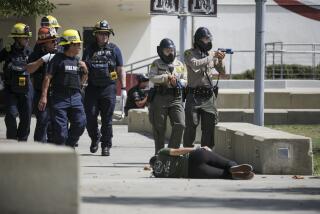Schoolsâ Mock-Quake Drill Upsets Principals, Parents
Principals, teachers and parents are balking at a Los Angeles Unified School District plan to stage a mock 7.5 earthquake next week, claiming the drill would be an all-too-vivid reminder of Januaryâs magnitude 6.8 temblor.
Students still are too traumatized by the quake and its aftershocks and will not react well to an extensive practice drill, according to some critics.
The annual drill, scheduled for Tuesday, also could be difficult for teachers and other school staff members, who lost homes and possessions in the quake.
âI think weâve had enough practice,â said Maureen Diekmann, the principal at Van Gogh Street Elementary in Granada Hills, which remains closed--with its students relocated--because of earthquake damage.
âWeâre definitely not going to do the whole nine yards. Weâre not going to have anyone hurt and weâre not going to have anyone stuck anywhere.â
School district officials say that the drill, called Shake â94, is scheduled every year at this time to coincide with the state-designated Earthquake Preparedness Month and that it is particularly important this year to test schoolsâ emergency plans.
âDo we stop everything?â said Jim Sugahara, a district administrator who oversees the emergency services office. âIf you have a car accident, when do you go back in the car? How long do you want us to wait? Iâd rather see our schools prepared and going through this exercise than not.â
The bulletin sent to schools describing Shake â94 tells principals to simulate a magnitude 7.5 quake at 10:30 Tuesday morning.
âThe impact upon the metropolitan Los Angeles area is significant,â the memo says. âPower, water, gas, sewer and telephone systems fail in all areas. Freeway bridges have collapsed, critically disrupting the transportation system. Fires are reported at District sites. Hazardous materials are released into the air in South Gate. Superintendent Sidney A. Thompson declares a state of emergency and orders staff to remain at their sites.â
The drill typically is elaborate. Students pretend to be injured or missing and some are carried off in stretchers. Teachers administer first-aid and conduct search-and-rescue missions. Others hold up signs depicting fires. A large aftershock hits 25 minutes into the drill.
This year, however, principals across the district say it will be a low-key affair.
âI donât think the kids need to go through this--theyâve been through enough already,â said Dan Balderrama, the principal at Langdon Avenue School in North Hills, where about 70 students just returned after the January quake. âWeâll just walk through it with the office staff and support people.â
And at Canoga Park Elementary, Assistant Principal Sara Applebaum said: âWeâre still living it. We havenât stopped living it. Ideally, weâd like to not have to think about this again.â
At Hobart Boulevard Elementary near Downtown, teachers will be told to keep reminding students that it is just a practice.
âWeâre trying to take every precaution so that our children wonât be scared by it,â said Betty Daniels, the assistant principal in charge of the drill. âMy main emphasis will be to reassure the children that everything will be all right.â
Rather than a 45-minute drill, most principals said they will scale it back to about 10 minutes and avoid giving students much description about the effects of the simulation. Some principals say students have just returned to school, others are sharing homes with two and three families, and still others are getting counseling because of quake trauma.
âThe kids need more structure, more stability,â said Debbie Moorman, whose daughter attends Kennedy High School in Granada Hills, where classroom buildings are closed and students take classes in portable bungalows. âI donât think itâs wise right now. I think they should wait until at least the fall semester.â
Schools are required to test their emergency communications plans and submit an evaluation of Shake â94. The questionnaire asks principals for recommendations to improve the schoolsâ plans and whether any major problems developed during the exercise.
All district schools are required to have an emergency plan that includes having teachers assigned to various search-and-rescue and first-aid positions. Schools are required to have emergency supplies, but the level of preparedness is spotty throughout the district.
Some schools have enough supplies to keep students on campus for 72 hours after an emergency, while others barely have enough for the day. The district is reviewing its emergency plans and schoolsâ supplies in the wake of the Jan. 17 quake.
Emylou Ballard, the president of the 10th District Parent Teacher Student Assn., said local schools should decide how to conduct the drill and whether their students and staff can handle it.
âMaybe they should have more psychological mending and education (about quakes),â Ballard said. âBut the more kids understand what will happen, the better theyâll be able to handle a big earthquake.â
Some parents and teachers agreed. Said Pamela Goldstein, a teacher at Van Nuys Elementary: âThey (the students) really do need an avenue to talk. Itâs good to open it up for discussion.â
But even with the drill, some parents and others say the schools still are unprepared for a quake. Practice, they say, wonât make schools perfect.
âSchools just arenât ready and able to handle a big earthquake,â said Helen Fallon, a parent who has criticized the districtâs quake readiness. âI think kids need to know that schools are prepared and safe.â
More to Read
Sign up for Essential California
The most important California stories and recommendations in your inbox every morning.
You may occasionally receive promotional content from the Los Angeles Times.










